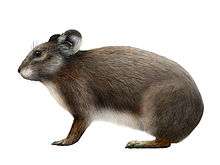Sardinian pika
| Sardinian pika[1] Temporal range: 5.33–0.002 Ma | |
|---|---|
 | |
| Scientific classification | |
| Kingdom: | Animalia |
| Phylum: | Chordata |
| Class: | Mammalia |
| Order: | Lagomorpha |
| Family: | Prolagidae |
| Genus: | Prolagus |
| Species: | P. sardus |
| Binomial name | |
| Prolagus sardus (Wagner, 1832) | |
| Synonyms | |
|
Prolagus corsicanus | |
The Sardinian pika (Prolagus sardus) was a pika native to the islands of Sardinia, Corsica and neighbouring Mediterranean islands until its extinction in the late 1700s or early 1800s. It was described by early Sardinian authors as "a giant rabbit with no tail" .
The Sardinian pika became extinct in Sardinia and Corsica probably during the Roman times. However, the species could have survived on small islands near Sardinia up to until about 300 years ago. The last surviving population probably existed in the island of Tavolara (which, in particular, was uninhabited until about 1780) off the coast of Sardinia, where Francesco Cetti mentions in 1774 the existence of "giant rats whose burrows are so abundant that one might think the surface of the soil had been recently turned over by pigs".[3][4]
Prolagus was an abundant source of food for many predators in the Pleistocene, like birds of prey and the Sardinian dhole (which seems to have evolved on the islands mainly to hunt this lagomorph). The presence of Prolagus also facilitated the establishment of the first human communities of the islands.
Jean-Denis Vigne found clear evidence that the Sardinian pika was hunted and eaten by people. He found that many of the Sardinian pikas' limb bones were broken and burnt at one end, suggesting that this animal had been roasted and eaten by the Neolithic colonists of Corsica.[5]
The full skeletal structure of the Sardinian pika was reconstructed in 1967, thanks to the numerous finds of bones in the Corbeddu cave, which is near Oliena. Some years later, from these remains, the same researchers, led by paleontologist Mary R. Dawson from the US, were able to reconstruct, with good accuracy, a reconstruction of plaster. The Sardinian pika was probably much stockier and robust than the species of living lagomorphs, and it probably resembled a sort of cross between a large wild rabbit and a pika.
P. sardus became extinct on the islands of Sardinia and Corsica due to the introduction of new predators (dogs, cats and small mustelids) and ecological competitors (rabbits and hares). Also, the extinction of P. sardus may be partly because of the transmission of pathogens by rabbits and hares introduced to Sardinia and Corsica by the Romans.[6]
Prolagus sardus weighed about 504-525 g. This is more than its ancestor Prolagus figaro, which is the only other member of Prolagus that is found in Sardinia. Prolagus figaro weighed about 398-436 g.[7]
References
- ↑ Hoffman, R.S.; Smith, A.T. (2005). "Order Lagomorpha". In Wilson, D.E.; Reeder, D.M. Mammal Species of the World: A Taxonomic and Geographic Reference (3rd ed.). Johns Hopkins University Press. pp. 193–194. ISBN 978-0-8018-8221-0. OCLC 62265494.
- ↑ Smith, A.T. & Johnston, C.H. (2008). "Prolagus sardus". IUCN Red List of Threatened Species. Version 2008. International Union for Conservation of Nature. Retrieved 6 January 2009.
- ↑ Kurtén, Björn (1968) Pleistocene Mammals of Europe. Weidenfeld and Nicolson, London
- ↑ Storia Naturale di Sardegna (PDF). Ilisso. p. 190. ISBN 88-87825-07-6. Retrieved 10 July 2016.
- ↑ The Archaeology of Animals. Simon J.M. Davis. p. 124.
- ↑ Sardinian Pika: EMA Database , European Mammal Assessment (EMA), 2007. Retrieved on the 11 May 2008 .
- ↑ http://riviste.unimi.it/index.php/RIPS/article/view/6905
